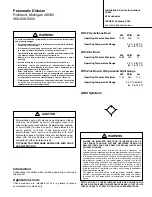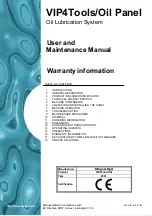
www.auga.nl
34
Important:
If there are people in the water, the pressure filter is not
allowed to operate.
The pressure filter may only be set-up out of the water. The pressure
filter has a protective class IPX4.
Only pumps with a maximum pressure of 6m (0.6 bar) may be
connected.
Make sure that water can always flow into the pressure filter, never close
all the outlets of the pressure filter before the pump is switched off.
Clean the drain hoses and filter regularly to prevent clogging, as this
may cause the pressure in the filter to rise.
The maximum discharge head after the pressure filter must not exceed
2m. (Refer to illustration 1.)
Connect hoses designed to work at a minimum pressure of 0.5 bar.
Protect the pressure filter against strong sunlight.
The pressure filter is only suitable for fresh water, without chemical
additives and with a minimum temperature of 5 ° C and a maximum
temperature of 35 ° C.
Position the pressure filter on a firm and level surface.
The VarioPress Pro 24000 and 40000 pressure filters are to be partially
dug in, up to the lid of the pressure filter.
To avoid running the risk of water freezing in the pressure filter, turn it
off and run it empty. Store the pressure filter frost-free or ensure that it
can no longer fill up with water.
Operating pressure filter
(illustration 2, 3 and 4, page 3)The pressure filter
with integrated UV-C unit is a closed filter system for mechanical and biological
filtration of the water in the garden pond.
A.
Inlet; connect the supply hose or PVC pipe here that is connected to the
outlet side of the pump. The maximum pump pressure should be 6m
(0.6 bar).
B.
Vortex; floating particles and deposits are deposited by centrifugal and
gravitational forces.
C.
Mechanical filtration; dirt particles are trapped on the filter foam, as the
water passes through the filter.
D.
Biological treatment; by micro-organisms that settle on the open pores
of the filter foam and bio-balls. The yellow and blue filter foam with
different sizes and densities, create different water flow rates. In the
areas with strong currents (blue filter foam), where micro-organisms
convert ammonia to nitrate through nitrification. Low flow areas (yellow
foam), on the other hand, contain anaerobic micro-organisms that
convert nitrate to nitrogen (de-nitrification).
Biological cleaning: by the bacteria that settle on the bio-balls.
E.
UV-C radiation; the water will be briefly exposed to ultraviolet radiation
from the UV-C lamp. This kills floating algae, germs and bacteria, when
the algae die, they clot together and can be captured by the filter.
F.
Outlet; connect the return hose or PVC pipe to the pond or water to this.
The water will flow back from the filter into the pond.
This valve is open during normal operation and must be locked in the
back-wash function. WARNING: The return hose or PVC pipe should not
exceed an elevation of 2m after the filter.
G.
Waste water outlet; connect the waste water hose or PVC pipe to this
outlet. Dirty water from the filter can easily flow into the garden and
English

































